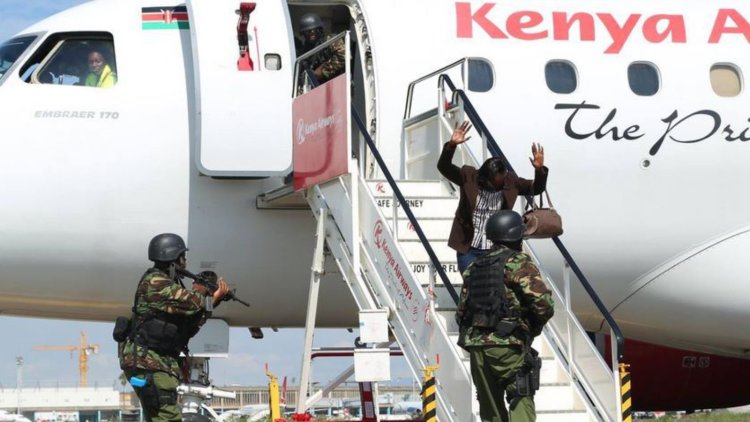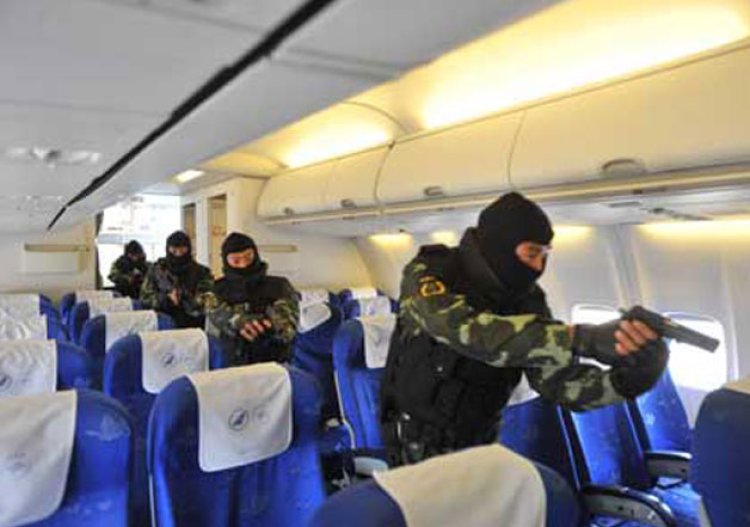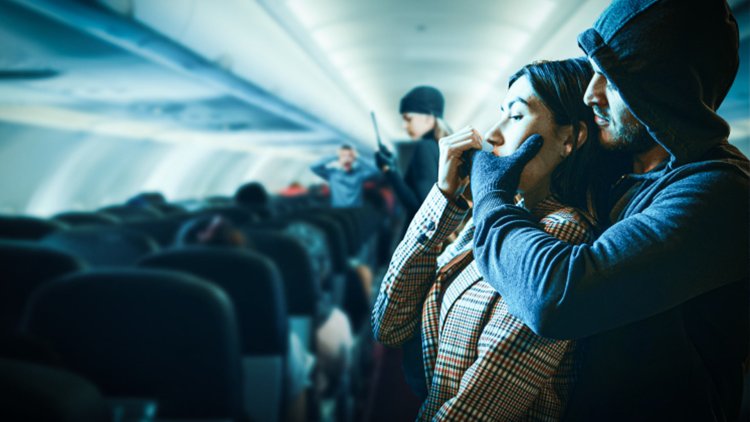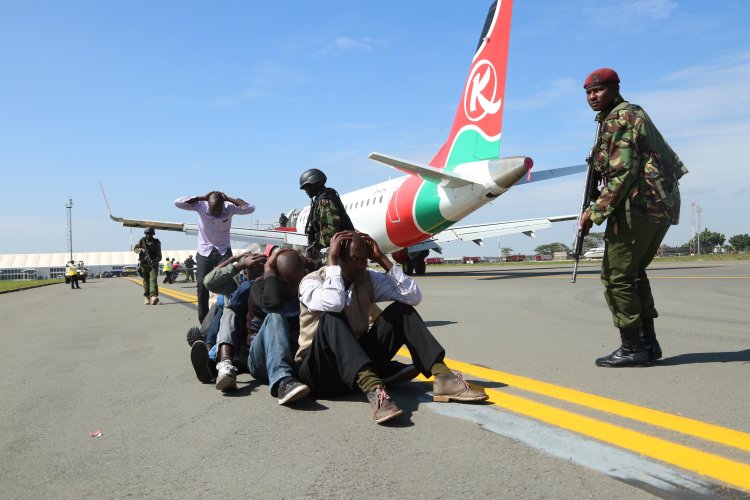How To Survive A Plane Hijack: Dos And Don'ts
The current odds of being in a flight hijacked by terrorists are about 10,408,947 to one owing to enhanced security measures within aircraft and across airports.

While a plane hijacking these days is an extremely rare occurrence compared to the 60s and 70s when it was prevalent, this is one experience that many travellers would not even wish upon their worst enemy.
The thriller miniseries, 'Hijack', starring English actor and DJ, Idris Elba, which is currently streaming online, brought to the fore scenarios whereby one can be travelling on an ordinary flight, be it domestic or international, but be a victim to terrorists forcefully taking control of a plane with sinister motives.
Simply put, hijacking a plane is akin to a boat or ship being taken over by pirates, but it happens in the air instead of on the water. The first plane hijacking in the United States took place in 1961, but the so-called “golden age” for hijacking was between 1968 and 1972 when more than 130 flights were hijacked, sometimes more than one plane being hijacked daily.
By the end of the 1970s, the Federal Aviation Administration (FAA), an operating mode of the U.S. Department of Transportation used x-ray screening of luggage, passenger screenings, and metal detectors.

A photo of hijackers inside a commercial aircraft. /INDIA TV NEWS
Following the terrorist attacks of September 11, 2001, hijackings became increasingly rare, thanks to the solid reinforcement of cockpit doors and higher security in airports across the world.
In Kenya, one of the most famous hijacking incidents took place in December 2000 whereby a mentally ill passenger stormed the cockpit of a British Airways Boeing 747 aircraft, flight 2069 flying from the UK to Nairobi, and attempted to hijack the aircraft, nearly killing 379 passengers and 19 members of the crew on board.
The 27-year-old Kenyan national had rushed into the cockpit, grabbed the plane's controls and pushed the Boeing 747-400 into a series of nosedives, going overboard to even biting one of the pilot's ears and finger amid screams from the 319 passengers before he was eventually apprehended.
The current odds of being in a flight hijacked by terrorists are about 10,408,947 to one owing to enhanced security measures within aircraft and across airports.
Viral Tea however breaks down what to do and not do in case the plane you're travelling in is hijacked:
Don't Be Aggressive
This is because hijackers are armed and usually tend to be nervous. In most jurisdictions worldwide, hijacking is punishable by life imprisonment or a long death sentence.
Their choice of weapons varies, with guns and knives being common, however, some attackers can brandish hand grenades or explosives that can cause consequences to the entire aircraft, especially if it is airborne.
In the midst of a stressful situation, do everything you can to avoid creating tension. Try to calm other passengers, and listen carefully to any instructions the hijackers or flight attendants are giving.
Prepare mentally for being in a living nightmare, and try to focus on what you’ll do or who you’ll see when the hijacking is over.
Furthermore, think twice about fighting back as more hijackers could be hiding amongst passengers on the flight. Your attack could trigger a disaster and cost everyone their lives.
Be Invisible
Stay silent and try to blend in with the rest of the passengers. Don’t look at your captors and don’t make any comments unless it’s to calm and reassure your family or someone close to you.
Furthermore, keep your head and eyes down, don’t speak unless spoken to, and be docile. Don’t make the hijackers take you hostage.
If they pull you aside to interrogate you, be polite and don’t make any sudden movements, keep your answers short, and don’t talk about politics.

Illustration of a passenger taken hostage by a hijacker. /WHAT IF SHOW
Minimize the importance of your job and give minor, ordinary details of your trip. If they accuse you of something, deny it calmly and respectfully.
Don't Panic
According to the US National Terror Alert site: “Remember that the hijackers will be extremely nervous and probably as scared as you are. Although they may appear calm, they cannot be trusted to behave reasonably or rationally.
Fear can trigger a disaster. One wrong move by either a victim or a hijacker could easily set off a defensive spate of violence, thus the best outcome of a plane hijacking is a “peaceful resolution of the situation.”
“Comply with their instructions. Do not struggle or try to escape unless you are absolutely certain of success," add the guidelines.
Observe & Analyze
Try to take mental notes about the hijackers, including their height, body structure, clothing, and how they refer to each other as well as if there’s a leader.
This could be helpful if they escape after the plane lands or if you survive and need to testify during a trial. It could also help you identify who to attack if you have to fight.
Don't Push the 'Call' Button
The sudden 'ping' tone in an aircraft is enough to startle the hijacker and provoke him to fire his gun. One gunshot can puncture the fuselage of an aircraft and when it is airborne, can lead to a loss of cabin pressure which in turn leads to hypoxia (loss of oxygen) which can be fatal.
If you require assistance or must go to the lavatory, raise your hand. Captors permitting, there will be normal beverage service aboard the plane and in some cases, abnormal beverage service.
Fight for Your Life
In some cases, you will have no choice but to face the attackers head-on.
If a group of passengers tries to coordinate a revolt, or if the hijackers make it clear that they are on a suicide mission, try and get items like beverage cans, alcohol bottles, the food and beverage carts, and other heavy objects to use to barricade and surprise the attackers.
If a plane is hijacked pilots will use a special code to communicate such a scenario to air traffic control back on the ground. This code of 7500, sent through an electronic device called a transponder, signals a hijacking or unlawful interference.
This communication, called squawking, is done silently so that the hijacker remains unaware, thereby creating an advantage for pilots.
Escape
If the confrontation happens when you’re on land, or if an assault force attempts a rescue, don’t fight and stay out of the way.
Stay low to avoid any gunshots that could be fired, and crawl towards an emergency exit. Try to use inflatable slides since jumping out of the plane could be dangerous.
When you land, run with your hands up and cooperate with the authorities until they realize you’re not a hijacker.


 admin
admin 




